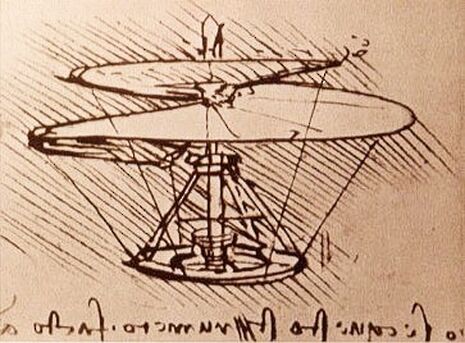Science and art go hand in hand. We must teach our children this
Zi Ran Shen asks whether our current education system is holding young people back from achieving their full artistic or scientific potential

In the ever-growing information age, education has become a cornerstone of society. Starting at the tender age of five, children are shuffled into a system designed to teach them information deemed necessary for their eventual functionality in the world. The different schooling systems, though varying from country to country, have a strikingly similar theme: kids enter primary school (or the equivalent) at around four to five years old, complete seven years of basic arithmetic, language and physical education, with a sprinkle of social and natural sciences, then move on to secondary school, which allows students some flexibility in their course selection — with the emphasis on whichever field they may want to continue their education in.
Naturally, the most noticeable divide in course selection is that between the humanities and the sciences. Stereotypically, students who excel in maths go on to explore the natural world while students who excel at the language explore the human condition. The tools of each trade are then introduced to their respective pupils. Aspiring scientists are taught to engage in a quantitative description of the world around them, using maths as a tool to reconstruct movements, molecules and energy. Humanists are taught to use thought as a tool to analyse previous and current ideas and build on them.
These vastly differing means of inquiry for the two schools of thought then naturally lead to different teaching methodologies. Humanities courses use discussions as a way to arrive at new material, while scientific courses dole out facts and let the students find their own way of understanding. While the separate methods seem to cater to the differences in the sciences and the humanities, imposing such opposing methods on young minds may have significant drawbacks.
“If I were not a physicist, I would probably be a musician”
Albert Einstein
Many educational systems offer some form of flexible course selection to the students when they are around the age of 15. One can choose to be in an easier stream for maths, or drop that difficult second language, maybe skip those thick literary books in lieu of some easy reading. These choices — seemingly innocuous — allow students to form different social groups and create different labels for each other. “I’m just not good at numbers”; “I’m not a languages person”; or: “How can you write so many words? I can’t even write a one-page essay.” At a stage when the brain is still developing, labelling students as either a humanist or scientist can alter their perception of themselves enough to change their development. Such a divide can prevent curious minds from learning valuable tools for whatever they intend to do in the future.
Thus, a chasm is created and perpetuated by the educational system. Humanists must think a certain way, as must scientists, and they shall not overlap. Despite the rigid early educational structure, in higher-level academia all tools blend together. Rigour and creativity are but two sides of the same coin. New scientific discoveries often require a complete shift in the paradigm, which cannot be achieved without creativity. One piece of evidence critically discussed over many hours can yield a new idea that shapes the world of science. Similarly, research in the humanities cannot be performed without rigour and logic. The best-made arguments are those backed up with well founded ideas and facts.

Historically, the separation between the sciences and the arts has been challenged by many prominent figures. Polymaths — experts of many fields such as the natural sciences, languages, art, poetry, sports, politics, etc. — were highly regarded by the ancient Greeks. Indeed, many iconic artists and scientists have made significant contributions to fields seemingly unrelated to their own. Benjamin Franklin was such a man: the founding father of America was known for his literary and political endeavours, but he was also an avid scientist and musician. Franklin was the first to propose the idea that lightning was electrical in nature. He famously, supposedly, flew a kite high into storm clouds to demonstrate their charge, which led to the invention of the ubiquitous lightning rod.
Leonardo da Vinci was another famous polymath who ventured deep into science in his spare time. He detailed the anatomy of man in ways that no one had before. He dissected the eye, analysed musculature movement, and was one of the first to reject the antiquated idea of the four humours which ruled medieval medicine. Da Vinci’s scientific endeavours were not only in the field of anatomy, but also in aerodynamics and hydraulics as well. He created a variety of machines, including a parachute, a diving bell, a hydraulic press, and many more.
Not only do artists contribute to the field of science – the reverse is similarly possible. One of the most iconic physicists of the 20th century was also a prominent musician. Albert Einstein once said: “If I were not a physicist, I would probably be a musician.” He played the violin often as a chamber musician, giving small private concerts with professional players as well as his scientist friends. Max Planck — the leading physicist on quantum mechanics — was one of his favourite collaborators both inside and outside the lab. These great thinkers and innovators shared a common curiosity — one that knows no boundaries between art and science.
Surprising as it may be that many scientists and artists share similar passions, it is in reality quite logical. The arts and sciences have a similar aim — to describe and explain. Thus, it is no accident that the two in fact inspire each other in new creations. Science and technology create new mediums from which art, such as photography, electronic music and light shows, can spring forth. New information technologies also allow many humanists to analyse statistical data that was not there before and come to brand new conclusions about the human condition. In return, the newfound art and human conditions inspire scientists to question the physical world further, wondering about the laws that makes us human, and make the universe what it is. All inquiries are born from the same curiosity and seek to explore the world we live in.
The ideal world that marries science and art is sadly deterred by reality. If the educational system continues to separate the two at an early developmental stage, the idea that the sciences are fundamentally different from the arts and humanities will persist.
The notion that arithmetic, communication, creativity or critical thinking is an inborn gift for a student to discover is fundamentally wrong. Expertise in these skills can only come from frequent practice. Instead of choosing a certain skillset early on, young students should be encouraged to practice as many skills as possible for as long as possible. Each field of interest should advocate the use of a range of techniques, technologies and collaborations. Only in this way can the collective effort of human endeavour be truly realised
 Comment / Plastic pubs: the problem with Cambridge alehouses 5 January 2026
Comment / Plastic pubs: the problem with Cambridge alehouses 5 January 2026 News / New movement ‘Cambridge is Chopped’ launched to fight against hate crime7 January 2026
News / New movement ‘Cambridge is Chopped’ launched to fight against hate crime7 January 2026 News / Uni-linked firms rank among Cambridgeshire’s largest7 January 2026
News / Uni-linked firms rank among Cambridgeshire’s largest7 January 2026 News / SU stops offering student discounts8 January 2026
News / SU stops offering student discounts8 January 2026 News / Cambridge businesses concerned infrastructure delays will hurt growth5 January 2026
News / Cambridge businesses concerned infrastructure delays will hurt growth5 January 2026








